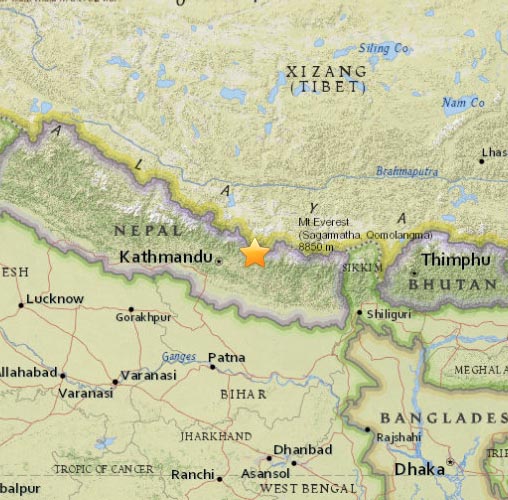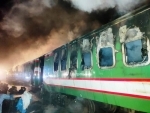South Asia

Five killed in Nepal, one in India in fresh tremor
Reports said more than 170 people were injured and many houses damaged in Nepal.
Four persons were killed in Sindhupal chowk, which suffered the heaviest death toll in the devastating earthquake of April 25 and one in capital Kathmandu.
There were three aftershocks following the tremor that hit Namchebazar, about 130 km from Kathmandu.
According to the U.S. Geological Survey, the earthquake registered 7.4 on the Richter scale, occurred at 12.45 pm (local time). The ground shook for at least 25 seconds.
Initial reports suggested that the epicentre was Afghanistan but it, later it was changed to Zham on the China-Nepal border about 83 kms east of Kathmandu and then finally to Kodari, Nepal.
Reports quoted Nepal Home Minister Bamdev Gautam as saying that few buildings have collapsed.
The airport in Kathmandu has been shut down.
Three major landslides reported in Nepal\'s Sindhupalchowk region with at least 12 people injured, reports said.
According to Nepal TV, the government has extended the closure of educational institutions by another two weeks. They had been ordered shut after April 25 and a review was to be taken on May 14, the last day of the Nepali month of Baisakh.
Nepal Police tweets, "Please stay in open field, help us make free road, do not make phone now busy. SMS is suggested."
The April 25 quake has so far killed more than 8000 people and left more than 17,000 injured.
In India, one labourer died after a wall collapses at an under construction site in Bihar\'s capital Patna.
The tremors were felt in Delhi, Bihar, Bengal, Odisha, Assam, Gujarat, Sikkim and Himachal. People of Chennai in Tamil Nadu also felt the quake.
Prime Minister Narendra Modi called a meeting and directed authorities to be on alert for rescue and relief operations.
In Delhi, buildings trembled for more than a minute and people ran into the streets. Metro services were halted for some time.
The underground railway services were suspended also in Kolkata.
Home Minister Rajnath Singh warned against panic. "Whatever help Nepal needs, we will provide it," he told reporters.
The home minister said the National Disaster Response Force or NDRF, which was deeply involved in the relief and evacuation efforts in earthquake hit Nepal, had been alerted.
"Please do not panic and maintain calm. Earthquake situation is being closely monitored and officials are already in the field," Delhi Chief Minister Arvind Kejriwal said.
People in many places, like in Gurgaon of National Capital Region, rushed out of their homes and offices. In Siliguri in north Bengal people also rushed out of offices.
"I saw chunks of concrete falling off the building in which our office is located," said an employee in a Siliguri office.
In Bihar towns and like Gaya and Madhubani felt strong termors.
Sikkim in northeast, which also borders Nepal, also felt it strongly.
According to US Geological Survey, seismicity in the Himalaya dominantly results from the continental collision of the India and Eurasia plates, which are converging at a relative rate of 40-50 mm/yr.
Northward underthrusting of India beneath Eurasia generates numerous earthquakes and consequently makes this area one of the most seismically hazardous regions on Earth. The surface expression of the plate boundary is marked by the foothills of the north-south trending Sulaiman Range in the west, the Indo-Burmese Arc in the east and the east-west trending Himalaya Front in the north of India.
The India-Eurasia plate boundary is a diffuse boundary, which in the region near the north of India, lies within the limits of the Indus-Tsangpo (also called the Yarlung-Zangbo) Suture to the north and the Main Frontal Thrust to the south.
The Indus-Tsangpo Suture Zone is located roughly 200 km north of the Himalaya Front and is defined by an exposed ophiolite chain along its southern margin.
The narrow (<200km) Himalaya Front includes numerous east-west trending, parallel structures. This region has the highest rates of seismicity and largest earthquakes in the Himalaya region, caused mainly by movement on thrust faults. Examples of significant earthquakes, in this densely populated region, caused by reverse slip movement include the 1934 M8.1 Bihar, the 1905 M7.5 Kangra and the 2005 M7.6 Kashmir earthquakes.
The latter two resulted in the highest death tolls for Himalaya earthquakes seen to date, together killing over 100,000 people and leaving millions homeless. The largest instrumentally recorded Himalaya earthquake occurred on 15th August 1950 in Assam, eastern India. This M8.6 right-lateral, strike-slip, earthquake was widely felt over a broad area of central Asia, causing extensive damage to villages in the epicentral region.



